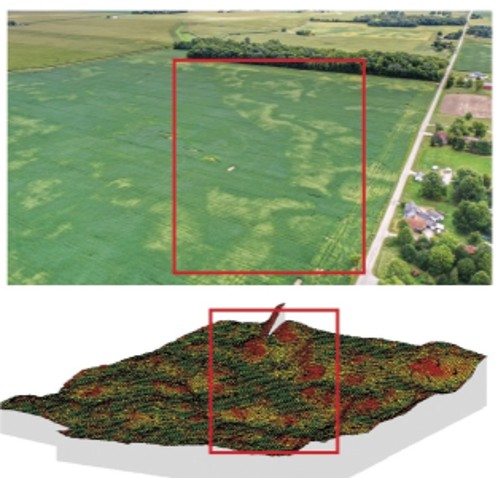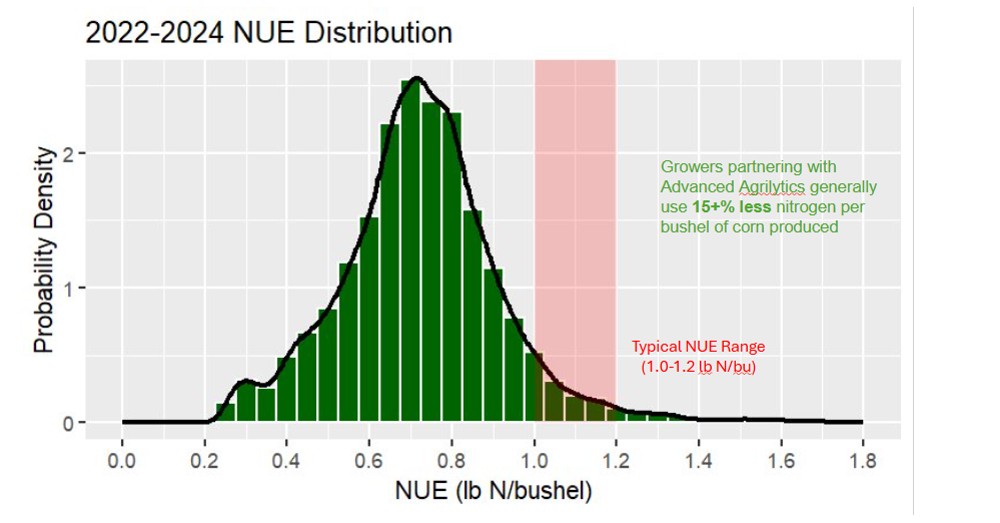By Dr. Kess Berg, Chief Innovation Officer, Advanced Agrilytics
As the 2025 planting season approaches, producers across the Corn Belt prepare to face the annual battle with the one major factor in crop production they can’t control – Mother Nature. From waterlogged fields to unexpected droughts, the season’s success often hinges on how well a cropping system is prepared to adapt—not react—to her infamous whims.
Advanced Agrilytics’ unique, data-driven analytical approach to proactive crop management is a key tool for helping row crop producers navigate Mother Nature’s shifts and turns more successfully. We examine soil mechanisms at the sub-acre level to analyze how things such as organic matter content, cation exchange rates, soil moisture movement and other factors affect nutrient availability and uptake, and in turn, plant health.
Predicting Response, Not Just Tracking Yield
Traditional agronomic practices often take a “cookie cutter” approach to nutrient application rates – applying a uniform rate across not just multiple fields, but across an entire farm, based on outdated critical level models most recently updated in the mid 1980s. We know that rainfall and soil moisture content are the main influencers of nutrient movement in the soil, plant growth and ultimately yield – so why don’t common recommendations or digital prescriptions take these key factors into account?
Advanced Agrilytics does. By integrating sub-acre spatial analysis into our methodology, our solution maps environmental variation across every field. Our proprietary TerraFraming™ platform analyzes these multiple datasets and creates customized prescriptions for a variety of agronomic practices such as:
- Lime
- P & K Fertility
- Variable Rate Seeding
- Variable Rate Nitrogen
- Variable Rate Nitrogen Stabilizer
- Variable Rate Starter Fertilizer
- Early Season Fungicide
Some of the foundational tools in this approach are the Soil Wetness Index (SWI) and Nitrogen Loss Potential (NLP) layers – two of several analytical options making up the company’s proprietary TerraFraming solution. These proprietary models classify in-field environments based on soil moisture movement, the topography of the sub-acre and other data. Rather than relying solely on soil type, the company incorporates a complex blend of elevation, slope, historical yield, organic matter, and crop rotation data to assign risk profiles and performance potential at the sub-field level.
This environmental mapping becomes the framework for all agronomic recommendations—from nitrogen rate and protectant variable rate strategies to starter fertilizer placement and seeding prescriptions.

In the top photo on the left, you can see where crops are in decline (yellow areas in the red box) due to a prolonged lack of adequate moisture in the field (10 days).
These areas correspond directly to the “high slope” parts of the acre identified in the Advanced Agrilytics Soil Wetness Index (SWI) map image below the photo (indicated by the red areas in the SWI map) .
By proactively identifying these areas which are prone to nutrient loss, we can help ensure the plants in this field have access to adequate nutrition throughout the growing season, using variable rate nutrient and N stabilizer applications.
Mechanism x Environment: A Systems-Based Approach
The Advanced Agrilytics methodology is based on understanding how biological and chemical mechanisms—such as mineralization, denitrification, diffusion, vegetative growth and development of increased plant mass, and seeding rate—produce effects that can influence nutrient availability or nutrient loss, which fundamentally results in a positive or negative yield response. By analyzing these relationships through a lens of spatial variability, the company identifies the conditions most likely to affect nutrient use efficiency, plant health, and ultimately, yield.
For example, saturated field areas are more prone to nitrogen loss through denitrification, especially in early spring. In contrast, high-elevation, water-limited zones often struggle with nutrient diffusion and require earlier or more targeted fertility to sustain early-season plant establishment and vigor. Using TerraFraming to analyze multiple data sets, Advanced Agrilytics provides customized, ready-to-use prescriptions to apply and maintain nutrient levels throughout the season in a more precise way—enhancing both environmental stewardship and economic performance.

This graph shows that Advanced Agrilytics customers have consistently demonstrated improved nitrogen use efficiency (NUE), with many using 15% or more less nitrogen per bushel produced compared to growers using conventional practices.
A Predictive Platform for Agronomic Decision-Making
Advanced Agrilytics takes a preemptive approach to managing chronic agronomic challenges. An understanding of the deeper mechanisms impacting yield directs management planning (either through specific prescriptions or redirecting the timing of crop interactions) prior to those issues occurring, thus decreasing risk. To this end, if in-season weather produces adverse conditions, the impact of those meteorological variabilities is reduced, and mitigation of the impact becomes less intrusive.
Unlike many traditional systems that rely on static recommendations, the Advanced Agrilytics model adapts season to season—based on environmental triggers, fertilizer mineralization dynamics, and predictive analysis of the likelihood of nutrient loss in specific areas of each field.
Spring prescriptions in particular benefit from this approach. Areas identified as saturation-prone can be prioritized for enhanced nitrogen stabilization or adjusted timing, while typically water-limited areas may require changes in starter application and sulfur availability to ensure early plant development. These decisions are rooted in the company’s sub-acre environment models, creating not just flexibility, but proactive precision.
Rethinking Fertility Beyond Grid Sampling
One of the key differentiators in Advanced Agrilytics’ system is its spatially-directed soil sampling methodology. Rather than following a fixed grid or zone-based approach, the company targets sample points representing unique field environments and then annually revisits those locations. The result is a rich, environment-specific dataset that reveals how different acres respond to inputs across a variety of seasonal conditions.
This information feeds into the company’s proprietary Spatial Critical Levels for phosphorus and potassium, which adjust fertility thresholds based on landscape position, water availability, and nutrient diffusion potential. It’s a significant departure from static university recommendations, and one that has shown consistent ROI—especially in historically underperforming field areas.
Building Resilient Acres Over Time
Rather than focusing solely on yield, Advanced Agrilytics emphasizes yield consistency across environments. The goal is not just maximizing output on the best acres but transforming previously underperforming areas into acres that consistently contribute to the farm’s profitability. Over time, the spatial system identifies areas prone to nutrient loss, moisture stress, or disease pressure, and deploys prescriptions that turn those acres historically labeled “poor performers” into assets.
This approach builds resilience over multiple growing seasons. Building up data on their customers’ farms year after year allows Advanced Agrilytics to continuously evolve their prescriptions. As data layers deepen and recommendations evolve, many customers report fewer surprises during challenging weather events and better performance in areas previously written off as “poor performers.”
As spring 2025 unfolds, this forward-looking model may represent one of the most valuable tools available to commercial corn and soybean producers seeking to protect yield, preserve nutrients, and improve their return on every acre.
© 2025 Advanced Agrilytics Holdings, LLC. All rights reserved. Advanced Agrilytics, TerraFraming, and designs are trademarks of Advanced Agrilytics Holdings, LLC.